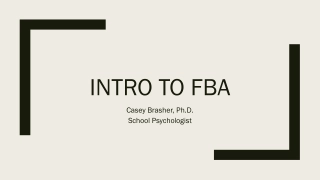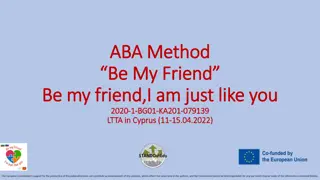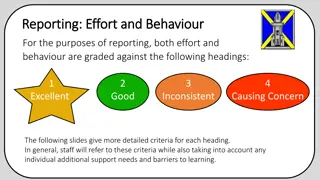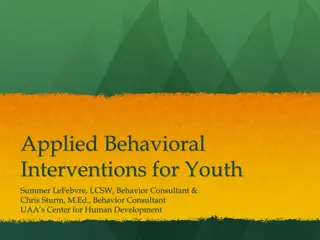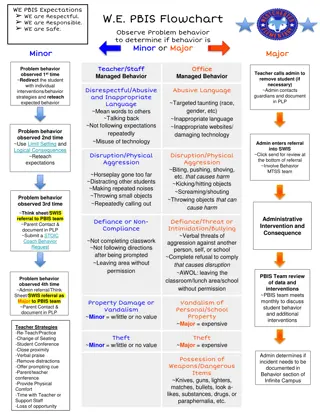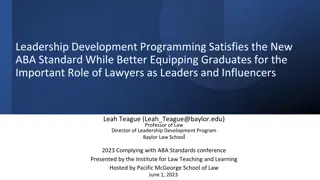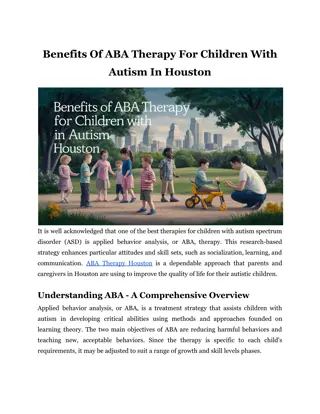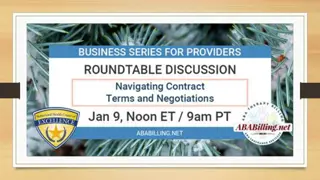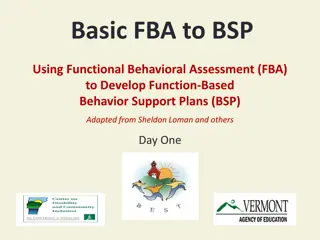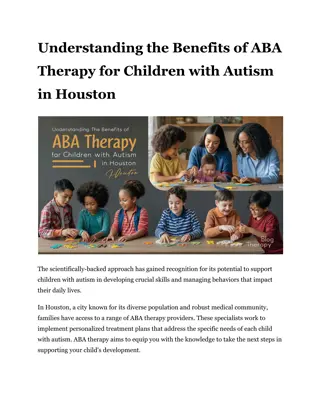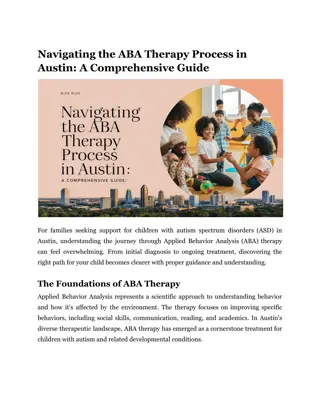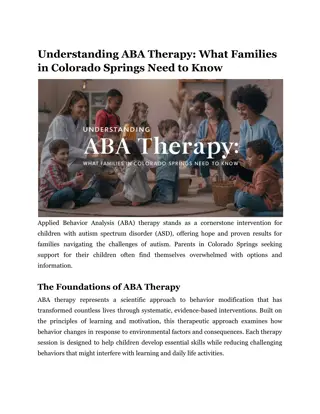Understanding Fundamentals of ABA & Behavior Support Strategies
ABA utilizes evidence-based interventions to enhance skill acquisition and reduce challenging behaviors, focusing on socially significant areas of development. The content covers key concepts such as defining ABA, ABCs of behavior, functions of behavior, and effective strategies to support behavior. It discusses the importance of analyzing antecedents, behaviors, and consequences in educational and clinical settings to promote positive behavioral change and enhance overall quality of life.
Download Presentation

Please find below an Image/Link to download the presentation.
The content on the website is provided AS IS for your information and personal use only. It may not be sold, licensed, or shared on other websites without obtaining consent from the author. Download presentation by click this link. If you encounter any issues during the download, it is possible that the publisher has removed the file from their server.
E N D
Presentation Transcript
Fundamentals of ABA & Strategies to Support Behavior Crystal Martinez & Ebony Condon
Agenda Defining ABA ABC s of Behavior Functions of Behavior Replacement Behavior Consequences Behavioral Strategies
What is ABA? ABA uses evidence-based interventions proven to help with skill acquisition and behavior reduction. It focuses on socially significant areas of development.
ABCs of Behavior Antecedent/Behavior/Consequence of behavior used to analyze and manipulate environmental factors that maintain behavior Used in educational and clinical settings Implemented to directly change socially significant behavior Analysis of Antecedents ( triggers) Analysis of Consequences
ABCs of Behavior: Antecedent What happens directly before the behavior the behavior occurs? Possible antecedents: Denied access Presented with a task or demand Removal/ addition of attention Change in routine Transition
ABCs of Behavior: Behavior Behavior needs to be observable and measurable. Examples: Running out of the classroom without permission Hitting others with a closed fist Biting others and breaking skin Screaming to the point that you can hear it in another room Throwing classroom furniture towards others
ABCs of Behavior: Consequence What happens immediately after the behavior occurs? Do you want to increase or decrease the behavior? Possible consequences: Block/ Interrupt/ Redirect Ignore/ Remove attention Provide attention Modify/ Change demand Remove demand/ Break Access given
Functions of Behavior Why is the individual engaging in this behavior? What need is the child trying to get met? Functions: Sensory Escape/Avoid Attention Tangibles
Escape/ Avoidance Escape- A behavior in which the student is trying to get out of or avoid doing something. Ex: The teacher says it s time to do math. Jimmy stands up from his chair and starts to walk around the room. The teacher tells him to sit at his desk multiple times, but he doesn t listen and continues to wander. The teacher begins to ignore Jimmy. 30 minutes go by, and the teacher says it s time for recess. Jimmy immediately gets in line and walks outside with his class and begins to play.
Attention Attention- When one engages in a behavior to gain attention from others, getting social reinforcement from interactions with someone. Ex: No one is giving attention to Sally at recess. She begins to scream to gain their attention. Students go up to Sally and ask her what is wrong and if she wants to play. Sally in now more likely to scream in the future to get the attention of her peers.
Tangible Tangibles- Gaining access to something, someone, or some activity. Ex: Ryan and his classmates are eating snack in the classroom. Ryan realizes that his juice box does not have a straw. Ryan begins having tantrum. The teacher notices that he doesn't have a straw. She gives Ryan a straw.
Sensory Sensory- Doing something that feels good and elicits a pleasure response in the body. Ex: Samantha s teacher notices that during transitions, Samantha sucks her thumb. She also sucks her thumb when the volume of the classroom is loud.
Replacement Behavior Replacement behavior is a behavior that is socially acceptable and desirable that a child can do instead of maladaptive behavior that meets the same function (FERB) (FERB) Functionally Equivalent Replacement Behavior Needs to be in student s behavioral repertoire Ex: If a student engages in hitting behavior to get an adult's attention, a FERB could be to have the student raise his hand to get an adult's attention instead. We would teach the student a new way to receive attention, which would be by raising his hand.
Consequences Positive + Stimulus added Negative - Stimulus Removed Reinforcement increases frequency of desired behavior Positive Negative R+ R- Reward Relief Positive Punishment Negative Punishment Punishment decreases frequency of undesired be havior P+ P-
Positive Reinforcement Positive reinforcement is the contingent presentation of a stimulus, following a response, that increases the probability of rate response. Improves behavioral outcomes Immediate (within 1-3 seconds following targeted behavior) Schedules of reinforcement Differential reinforcement (DRA, DRO, DRI, DRL) AFIRM Modules | AFIRM (unc.edu)
Extinction The contingent removal of reinforcement for previously reinforced behavior, to decrease the occurrence of that behavior Ex: If a student engages in tantrum behavior to gain access to tablet, teacher will no longer provide student with tablet when he/she engages in tantrum behavior Ex: If a child engages in tantrum behavior to gain access to balloons as the grocery store, parent will no longer give child balloons when he/she engages in tantrum behavior at the store.
Negative Reinforcement The contingent removal, termination of a stimulus following a response that increases the future occurrence of that behavior. Negative reinforcement occurs when something unpleasant or uncomfortable is removed or taken away in order to increase the likelihood of a desired behavior. Ex: If a teacher wants to improve task completion in class, they could set the contingency that if student completes all classroom work, student will have no homework. Ex: If parent wants their child to eat dinner, they could set the contingency that if student eats their dinner, they will not have to do their household chore.
Antecedent Based Interventions Can be used to decrease a targeted behavior by manipulating environmental factors; preventative strategies Used to address; social, communication, behavior, school-readiness, play, motor, adaptive, and academic outcomes. Used to reduce; challenging behaviors, Strengthens transitions, communication skills, and social skills EX: priming, visual schedules/schedules, visual aides, timers, providing choices, frontloading
A Case for Antecedent Based Interventions A Case for ABI | AFIRM (unc.edu)
Functional Communication Training Functional communication training is used to address interfering behaviors by providing a child with a replacement behavior in the form of functional communication EX: Interfering Behavior Behavior Replacement Communicative Behavior Function of Aggression, Property Destruction, Elopement Aggression, Tantrums, Screaming Avoid task demands Ask for a break Obtain preferred item or activity Request item or activity Autism Focused Intervention Resources & Modules (AFIRM)
A Case for Functional Communication Teaching A Case for FCT | AFIRM (unc.edu)
Modeling Modeling is an evidence-based practice that supports skill acquisition by having a student/child observe the correct performance of a desired behavior.
A Case for Modeling A Case for MD | AFIRM (unc.edu)
Citation Sam, A., & AFIRM Team. (2016). Modeling. Chapel Hill, NC: National Professional Development Center on Autism Spectrum Disorder, FPG Child Development Center, University of North Carolina. Retrieved from http://afirm.fpg.unc.edu/modeling Sam, A., & AFIRM Team. (2016). Antecedent-based intervention. Chapel Hill, NC: National Professional Development Center on Autism Spectrum Disorder, FPG Child Development Center, University of North Carolina. Retrieved from http://afirm.fpg.unc.edu/antecedent-based-intervention Griffin, W., & AFIRM Team. (2017). Functional communication training. Chapel Hill, NC: National Professional Development Center on Autism Spectrum Disorder, FPG Child Development Center, University of North Carolina. Retrieved from http://afirm.fpg.unc.edu/functional- communication-training


